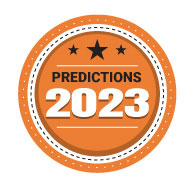
Five cloud computing trends that will impact businesses in 2023


 With more than 94% of enterprises using cloud computing, businesses have undergone a significant digital transformation. As industries move forward, many look for diverse ways to improve their business continuity, work operations, scalability, sustainability, and profits.
With more than 94% of enterprises using cloud computing, businesses have undergone a significant digital transformation. As industries move forward, many look for diverse ways to improve their business continuity, work operations, scalability, sustainability, and profits.
The adoption of cloud computing has led to the most transformative tech trends, including artificial intelligence (AI), the internet of things (IoT), cloud gaming, and remote and hybrid working. Cloud computing is set to transform even more technologies, including virtual and augmented reality (VR/AR), the metaverse, and quantum computing.
Here are five cloud computing trends that will have the most impact on businesses in 2023.

Security
With the adoption of cloud computing, industries will witness a massive investment in security. As cloud migration increases, businesses are looking to reduce cybersecurity threats and the risk of fines related to legislation around how businesses can store and use personal data.
The International Data Corporation (IDC) has also predicted that more than 40% of organizations will leverage cloud computing by 2024 to enhance performance, security, and compliance requirements.

Data & App Modernization
Modernization is essential in enhancing the quality of the application and making data experiences even faster. As a result, cloud solution providers like Microsoft are putting real efforts into offering various database modernization tools, such as Azure DevOps and Azure API Management, to reduce complexity and increase agility.
This cloud computing trend will redefine how entrepreneurs do business in the upcoming year by modernizing apps and data to accelerate time to market and achieve scalability, reliability, security, and high availability. This way, ISVs will be able to focus more on bringing innovations in their working styles.

Analytics
Analytics is a systematic computational analysis of data or statistics. On the other hand, cloud analytics involves deploying scalable cloud computing with powerful analytical software to deliver the expected results in the form of meaningful and actionable insights or identify patterns in data.
In the upcoming year, more businesses will rely on data analysis to gain a competitive edge in their industries, improve the work processes, and make real-time informed decisions. Because of this, the market size of the public cloud is expected to reach USD 649.62 billion by 2028.

Cloud Spend Management
This is a cloud cost optimization technique that enterprises use to understand and plan the budget and needs associated with cloud computing. Additionally, this makes it easy for businesses to find effective ways to manage expenses and maximize cloud usage.
In 2023, it is expected that hyper-scale cloud service providers like Microsoft will continue to innovate in this field and create more efficient solutions with powerful technologies like artificial intelligence (AI), no code, and low code.

By leveraging AI, enterprises will be able to reduce infrastructure and IT expenses by a significant amount, as predictive analytics provides insights on the expected cloud spending based on past usages. This way, enterprises will be informed and able to reduce cloud spending by switching to a better cloud plan that fits their usage requirements.
Multi-cloud
As businesses have already started to understand the worth of hybrid cloud, entrepreneurs would realize the benefits of diversifying their services across various cloud providers. The agenda behind multi-cloud is to ensure that businesses are more agile, scalable, and secure.

Reports have found that almost 84% of the companies from the mid-to-large scale will adopt a multi-cloud strategy by 2023, making it one of the promising cloud computing trends of the year.
Also, in a survey conducted for 750 tech decision-makers of Flexera, an IT consulting firm, it was found that businesses use 2.6 public clouds and 2.7 private clouds on average. That means companies are not stuck with a particular ecosystem, which helps to reduce the chance of system errors or downtime due to a critical failure of business operations.
As cloud adoption continues to accelerate, industries are going to witness a rise in all these cloud computing trends in the year 2023. Of course, cloud adoption and timeline may vary from company to company, but one thing is for sure, that companies must embrace cloud and focus on modernizing their IT in order to remain competitive.

